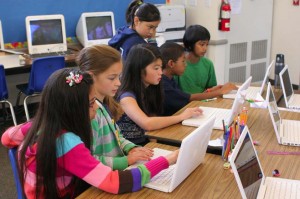
TB
In response to the article The 7 Golden Rules of Using Technology in Schools, teacher Patti Grayson wrote a point-by-point summary of exactly how it plays out in her class. Here's her take.
By Patti Grayson
Along with some colleagues in our lower school division, I lobbied to use money normally spent on workbooks and paper instructional materials to buy a classroom set of netbooks for our students. We’re only a month into the school year, and already, Bellow's golden rules have served me well. Here’s how they apply to my fourth grade classroom:
- DON’T TRAP TECHNOLOGY IN A ROOM. Best. Advice. Ever. If technology is used properly, it is a natural extension of learning – as useful as a textbook (and often more so). These days I say “Grab your netbook and…” more frequently than I ever thought I would. For students, this new way of instruction is seamless. When we are creating our own questions about a topic or digging deeper for information, they’ll ask, “Mrs. Grayson, can I get a netbook and look it up?” The netbooks have also provided the opportunity for daily keyboarding, blogging, math practice, web tool exploration anytime we have 15 minutes to fill.
- TECHNOLOGY IS WORTHLESS WITHOUT PROFESSIONAL DEVELOPMENT. Can I hear an amen? Bellow points out the wellspring of teaching knowledge accessible through YouTube and Twitter, and yet many of our teachers need help learning to wield these social media tools effectively. At our school, we've added a half-day of "connected learning" professional development each month. In addition, our 6-member digital learning leadership team is available after school to organize sessions in the computer lab or work one-on-one with teachers.
- MOBILE TECHNOLOGY STRETCHES A LONG WAY. As an elementary teacher, I don’t see much of this in my classroom, but we have worked to revise our middle and upper school policies to take advantage of opportunities presented by the wide availability of mobile devices. Many of our teachers are now allowing students to utilize these tools for recording lectures and presentations, as e-readers, for research, etc. Our journalism students are even tweeting school news on their cell phones.
- THE NEW ‘F WORD’ IS FEAR. It's so true -- many schools are in a "fear" mindset. We're fortunate to have an IT department that does not block YouTube, Twitter, and other great learning sites. Our filters are strong, but if something is blocked that can be useful in the classroom, it usually just takes a quick email to get the site approved and unblocked. Am I fearful of being replaced by cheaper delivery systems? Not at all. I know that developing children into knowledgeable and successful adults is not about content. My role is to teach students how to learn. Do I worry about them knowing more than I do? Nope. The amount of stuff to know about today is mind-boggling. We learn together and from each other. Want to get a kid excited? Let them teach yousomething.We’re also working hard to get parents on board. We had a technology night where we spoke to parents about Internet safety and digital citizenship. Our students are learning about these things in their computer resource class, and daily in our classrooms as they use technology. There simply must be time in the curriculum to teach students how to validate sources, represent themselves online, and create a positive digital footprint.
- TECH TOOLS ARE NOT JUST A PASSING FAD. Technology is ever-changing, but that doesn’t mean we can refuse to invest in it. Knowing this, our school has opted to lease our netbooks. If they become obsolete or something better comes along, we can adjust. If they have the opportunity for constant exposure and practice, students become proficient at applying their general knowledge of technology to new tools. Our role is to teach them the proper way to carry out the learning that the tools help enable. They will naturally adapt as new technologies emerge. Adam Bellow is right in saying that we are all natural lifelong learners.
- MONEY IS NOT THE PROBLEM. This may be the one place where Bellows and I disagree a bit. The money to provide sufficient digital devices to access the Internet makes an enormous difference in the seamless integration of technology. Just this week, my class Skyped with students in a less well-supported school as part of the Global Read Aloud Project. The class did not have a webcam mounted over a Promethean board as I do. Instead, the students gathered around the teacher’s laptop, using a $10 microphone. They had to move about more and share the mic. The teacher made it happen -- she took advantage of the free technology to involve her students in a literature experience with others across the country. We all gained some great insights by sharing our interpretation and predictions about the book. But those kids in that school were clearly on the wrong side of a digital divide. Money is a problem in their classrooms.
- INVITE EVERY STAKEHOLDER TO THE CONVERSATION. This is critical. Every stakeholder deserves a voice. At our tech night, parents voiced concerns and suggestions that helped us improve our teaching and our support for their children. Students are stakeholders too. In the classroom, the kids (who are frequently more tech savvy than we are) come up with great ideas and ways to use technology and share learning. Students should always feel encouraged to say, “What if we….”
We’re off to a great year!
Patti Grayson is an elementary teacher at Virginia's Hampton Roads Academy and a member of her school's digital learning leadership team. This year she's looping with rising fourth graders. She blogs at Patti's Ponderings and contributes to the group blog Voices from the Learning Revolution. Follow her on Twitter @pattigrayson.

